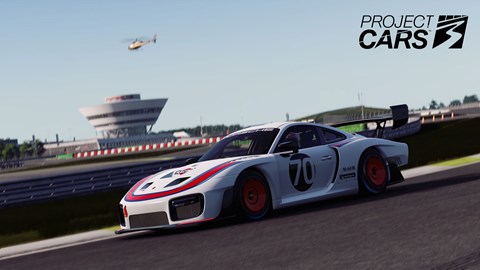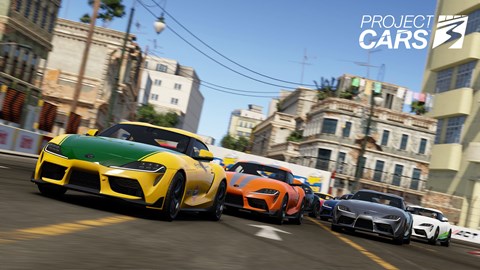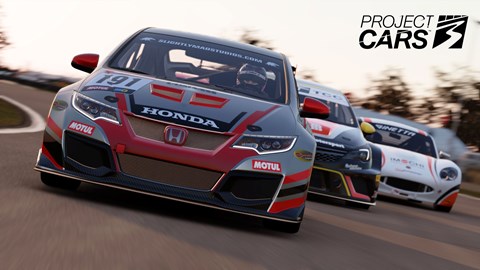► New multiplayer and career mode
► Arcade racer or life-like sim
► Out now on PC, Xbox One and PS4
Since its launch in 2015, the Project Cars franchise has gained a loyal and relatively large following within the sim-racing community. Initially reliant on crowdfunding, gamers had mostly forgiven the various quirks and rough edges of PC1 and PC2, instead lauding the titles as the only true console sim racing games outside of the Assetto Corsa series. In fact, many believed that any sequel was a mere physics tweak and UI improvement away from being one of the most well-rounded sim racing experiences going.
Best racing games
So imagine our surprise then when, in late 2018, Slightly Mad Studios CEO Ian Bell, announced that Project Cars 3 would be ‘more of a spiritual successor to (Need for Speed) Shift’ – a simcade racer launched in 2009. Granted, there were assurances that the sim aspect wouldn’t be forgotten, but subsequent information, trailers and blog posts on the game have done little to settle the nerves of diehard fans. Has the sim-goodness been lost or simply brought to a wider audience? Read on to find out…

Arcade or sim?
Despite boasting an accomplished physics engine, PC2 was certainly one of the more forgiving sims when it came to driving physics. And yet, to this reviewer at least, it was well judged to the point where seasoned pros and relative newbies could still enjoy the vast array of cars and tracks on offer.
Happily, SMS Studios insist that the underlying physics engine has been maintained. Yet, somehow Project Cars 3 still feels noticeably different from its predecessors. Cars are more forgiving and less individual in how they drive, with less nuance to fundamentals such as weight transfer and steering feel. What should be roaring engines feel muted at best (and downright odd at worst), while other sound effects such as tyre squeal and impacts with other cars are cartoon-like.
The excellent LiveTrack weather system remains, yet much of its appeal has been spoiled by the removal of pit stops, tyre wear and even different compounds. Sure, a wet track can still dry out as the race progresses, but the tyres on your car will stay the same, morphing to whatever the conditions warrant. Mechanical damage, a number of car tuning options and qualifying (at least in single player) have also been jettisoned. Hmmmm.
Something also has to be said for the sheer amount of on-screen graphics, readouts and displays that the game defaults to during driving. Add this to the motion blur and jarring in-game music, and PC3 screams arcade racer out of the box. You can of course turn most of the features off, yet you’re then left with a similar experience to PC2, except with what feels like a watered-down physics model. The graphics appear to have taken a hit, too – not helped by a highly saturated colour pallet and a number of glitches that have been carried over from PC2.

To judge a game purely against its predecessors, however, is a little short-sighted – especially when PC3 dares to bring the sim racer into such new territory. And, to its credit, the handling model (while no doubt a disappointment for PC1 and PC2 fans) continues to be better than what both Forza and Gran Turismo can offer.
Gamepad usability has also taken a massive leap from previous titles, to the point where you may question whether it’s worth getting the wheel out at all. No longer are you desperately trying to find the sweet spot in the myriad of controller settings that PC3 (to its credit) still offers, it’s simply a case of loading up a race and nailing the throttle. Accessibility has also been improved with a new version of the ‘dynamic racing line’, that uses braking, apex and corner exit markers to gently guide you around the track. A neat idea and one that will surely become more commonplace on racing titles in the near future.
XP dominates career mod
With over 200 cars and 120 track layouts from launch, there’s an admirable selection of content to rip through in PC3’s broad career mode. Again, those looking to closely recreate the feel of, say, Formula 3 or GT4 seasons will be disappointed, as each ‘campaign’ is broken down into a number of shorter quick-fire races where the goal is to gain as much XP as possible.
This can be done through placing well with higher difficulty settings (a la Forza Motorsport) and hitting objectives (complete 7 clean overtakes in one lap etc). As a concept, it treads the fine line between feeling fun and contrived. XP counters fill up left, right and centre after races, yet the attainable goals they create should satisfy those looking for a quick fix.
And talking of quick fixes, car upgrades have also been added and form a key part of your ‘ultimate driver journey’. The thinking being that you can take your humble road car and tune it up to the level of a full-on GT3 racer as you progress through the divisions. The end result gives you a greater feel of ownership and improves the ability to personalise (there’s also a basic car livery editor), yet it’s not a perfect system.

Going to add an aero package to the newly added Honda Civic Type R (which, oddly, is the previous gen FK2 that went out of production three years ago), I expected to see a big rear wing or front splitter. And yet, there was nothing – just an increased car performance rating.
Revamped multiplayer with scheduled races
At this early stage soon after release, we’ve only had limited experience with Project Cars multiplayer. Even so, initial impressions suggest it may well be the strongest part of the game. The iRacing inspired ‘Racing Licence’ of PC2 remains (a grade card of your driver skill and safety rating), yet it’s been complemented by new Scheduled Races (also borrowed from iRacing) and a Rivals time trial mode. The latter sees you take part in daily, weekly and monthly car and track combos, trying to set the fastest time possible. And, to make things more interesting, you’re placed in a division around similarly fast drivers, creating far closer competition.
Meanwhile, Scheduled Races bring a welcome layer of more serious, regimented racing with sign ups and qualifying forcing drivers to take them more seriously than your average quick play match up. On the evidence we’ve seen so far, there is some good racing to be had in these lobbies, yet it’s just a shame that those willing to exploit the handling model can’t enjoy the same core sim features (pit stops, tyre wear, fuel usage etc) afforded to Gran Turismo players.
Verdict
There’s undoubtedly a decent racing game in Project Cars 3, with a wide-ranging car and track list, promising multiplayer offering and solid physics engine – especially among other console titles. However, we can’t but help feel disappointed that its sim-racing USP has been taken away and replaced by a compromised version of itself that rival titles can ultimately do better.